Cyber Acoustics CA-3602a Review
Build 1.2 | Sound 1.7 | DSP Sound 3.6 | score breakdown
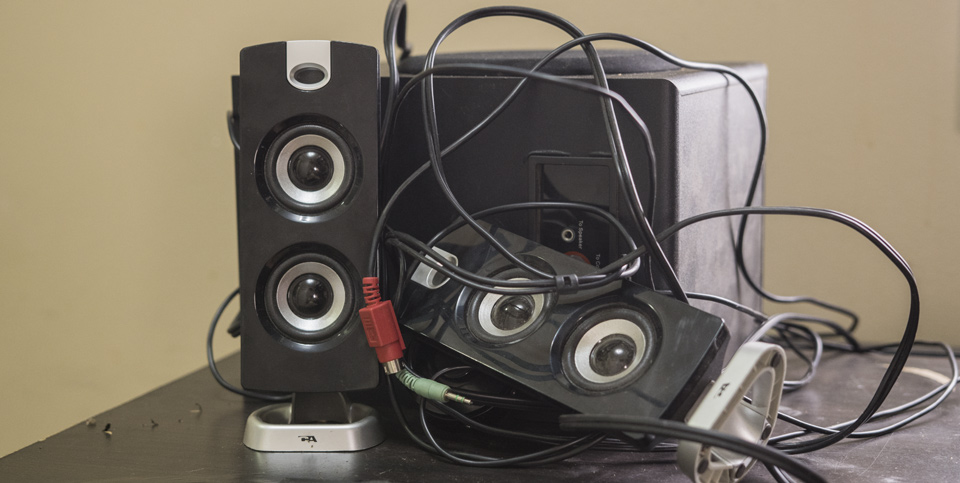
The Cyber Acoustics 3602a have been waiting for review for about 5 years. I've had them on my desktop twice for months at a time before this for review, and both times I was just unhappy with the DSP correction and my understanding of the speaker. I had all kinds of trouble nailing down the measurements and placement recommendations. After years of suffering with the Cyber Acoustics speakers performance I think I've got something worth sharing.
This may be my most important review, given that the Cyber Acoustics 3602a is probably the most popular stereo speaker system of all time. While the CA-3602a speakers are sitting in second place right now behind the Amazon basic speakers the Cyber Acoustics CA-3602a were in first place 7 years ago and held that spot solidly for 5 years. I would say that any product that sat on top of that list for that long is more than likely the top selling stereo speaker of all time - given that it is a global product and millions of people entered into the middle class from the new markets in India and China during that time frame.
It's no wonder that the speakers are selling well considering what is offered in this package is nothing less than incredible giving the price point. I don't grade on a curve, so my price is no object mentality will work against Cyber Acoustics in this review, but I wanted to mention that it is in fact a stupid good deal before ripping it to pieces figuratively and literally.
Component Overview:
Driver

Cheap metallic looking cones with large shiny plastic dust caps, and a foam surround that is soft and pointlessly high roll. There are dual 2 inch drivers per satellite. This is a strange configuration that is either the shortest line array, or an MTM without the T. Pros and cons of this configuration will be the addressed in detail further on in the review.
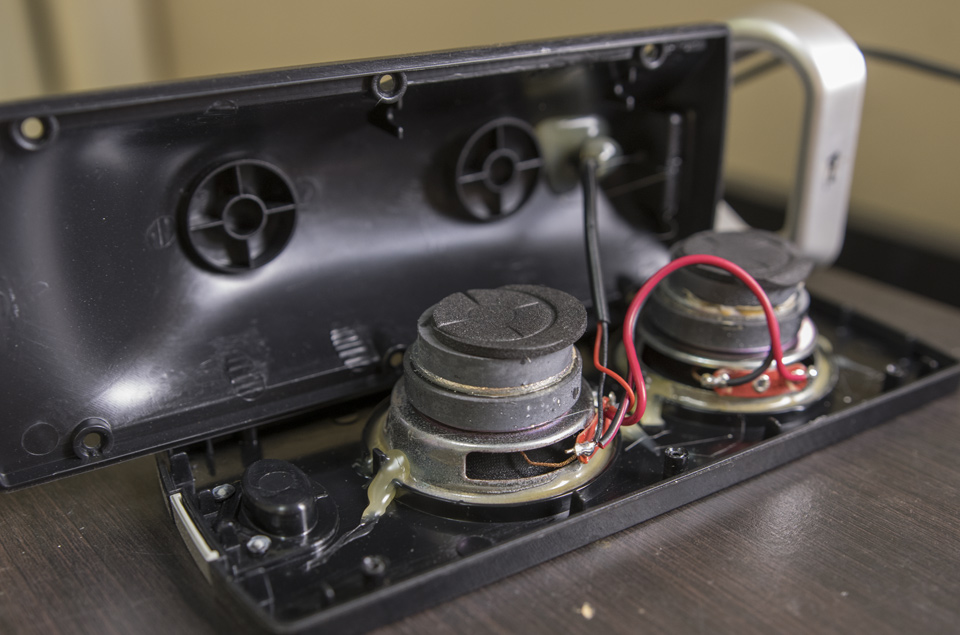
Back of the driver show a paper texture covering the cone that is either a coating the metal cone, or the paper cone is coated on the front with a shiny surface. Either way, the driver construction is it's more complicated than I expected.
The thick foam padding on the top of the drivers magnet structure is compressed when the cabinet is assembled. This is a nice attempt to stiffen up the cabinets using the drivers themselves as braces in the small cheap feeling plastic cabinets.
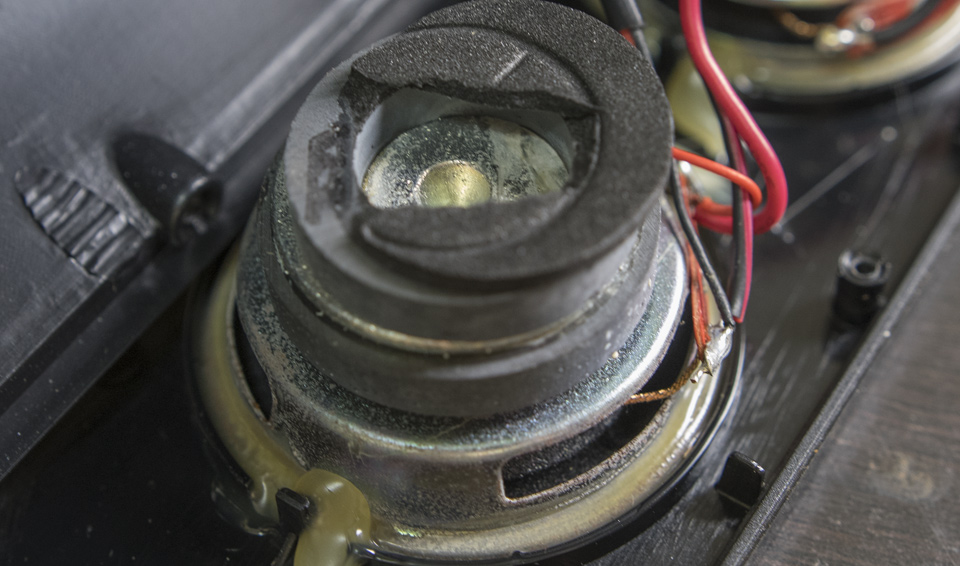
Pulling off the foam reveals a backing magnet that will help shield the speaker to avoid radiating magnetic interference. This also will increase the efficiency of the speaker slightly, making it able to play a little louder.
Grills
Props to Cyber Acoustics for implementing the best cost saving measure in audio - No Grills, No Grill Problems.
Subwoofer
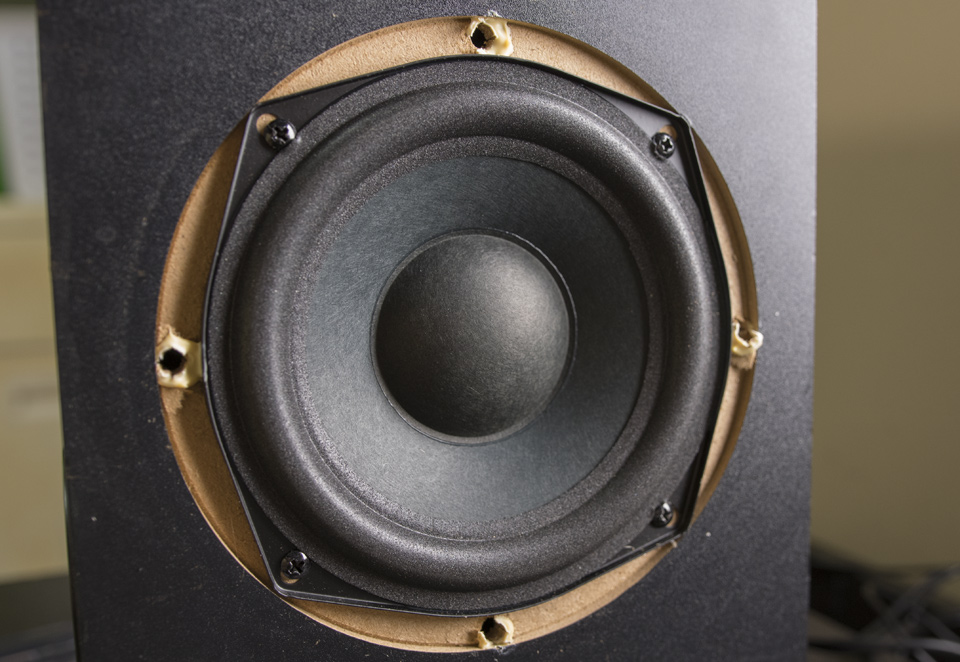
This is not a subwoofer, it's a shared woofer. The 5 1/4 inch driver crosses at 250Hz with the satellites, and the lowest I got it to play was 50Hz using ludicrous amounts of equalization. The cone material appears to be wool fiber, but the back of the cone looks like regular paper. Foam surround is a hair more throw than you would normally see for a woofer this size, and is soft and pliable after 5 years of storage and random abuse.
There was a grill on this speaker, but no screws, just four plastic posts wood glued into the cabinet. I do not suggest taking this grill off.
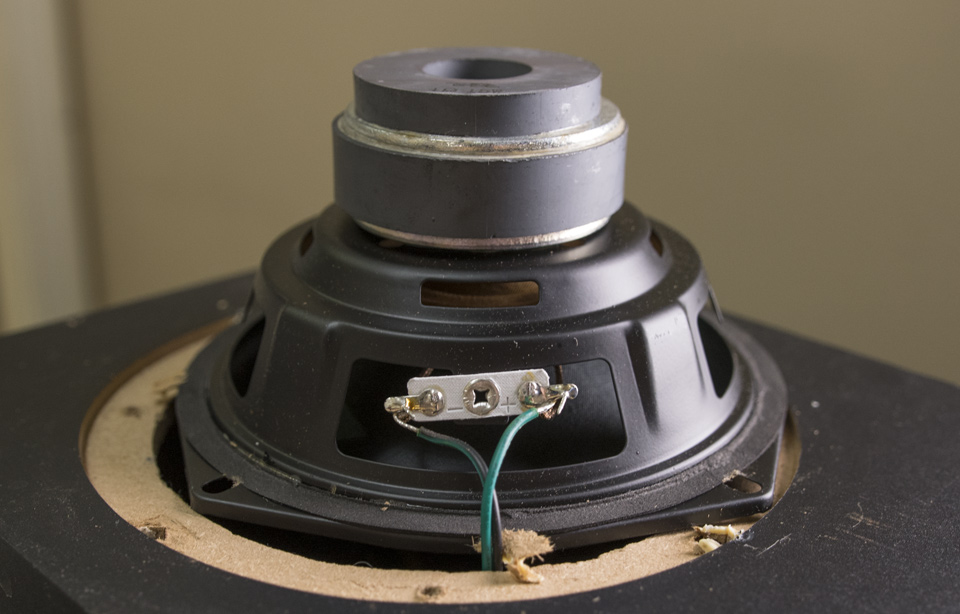
Back of the driver shows the aforementioned paper cone texture, some quick and nasty soldering on the terminals, and a large motor with a backing magnet to cancel magnetic radiation and increase output.
Subwoofer Port
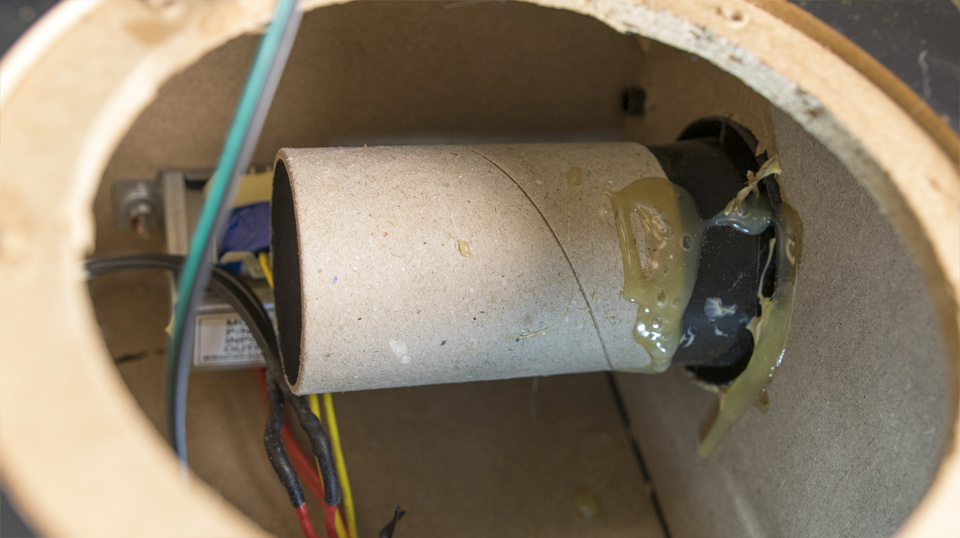
Port is a cardboard tube slathered with wood glue and stuck to the plastic flared end. This might be ugly, but stiff cardboard is a better port material than ABS/PVC plastic because it the cardboard will absorb some of it's own resonance. The KEF LS50 port tube uses a more high tech composite material to get the same effect, check out the white paper if you don't believe me(it's on page 17). It's not a bad material, but the mating is sloppy in implementation - there is a large 1/8 inch lip where the port transitions to plastic flare which could cause whistling.
Notice in the background the standard wall wart type transformer. It's nice that they put it into the box, which means that it uses a regular two prong power cord.
System Amp
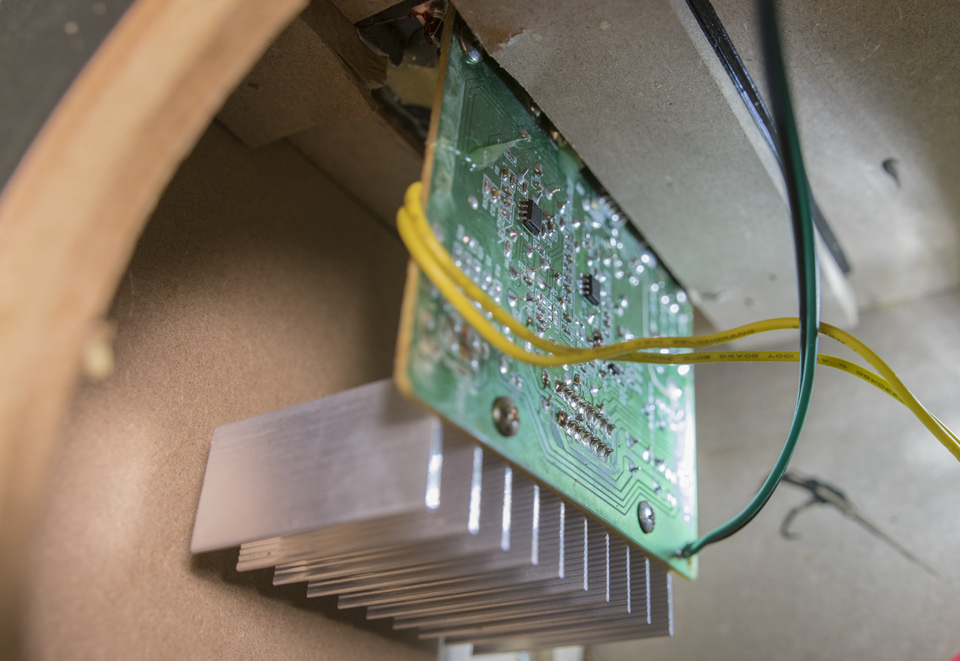
This is a very tiny amp. I could spot two op amps, and that they only used one amp chip which is the only thing attached to largish heatsink. The amp chip is probably designed for 2.1 systems and 3 channel output.
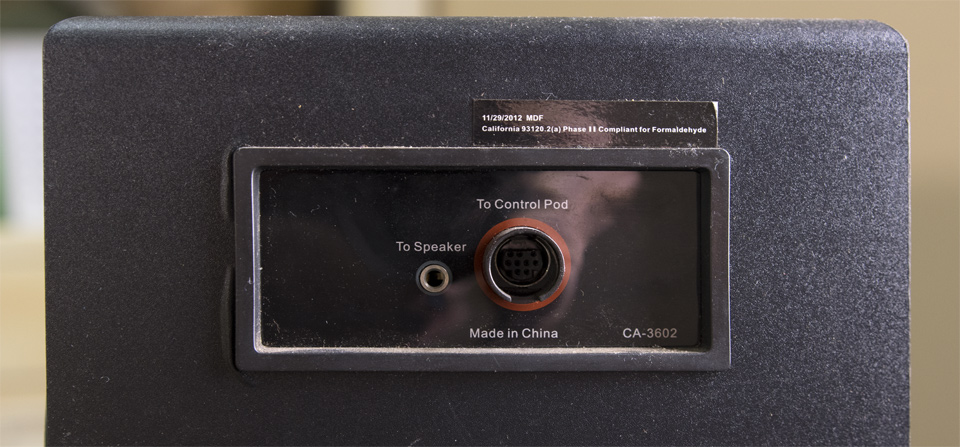
The remote control and satellites plugs into the sub, the cables are pretty short, but it worked well in my little room.
Remote
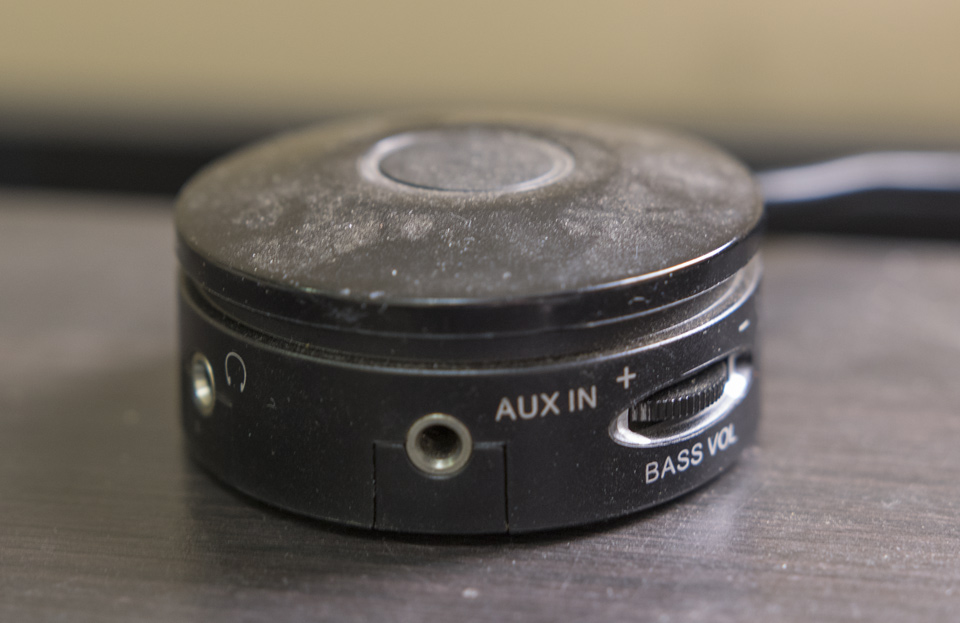
This remote control has to be the worst thing about this system. I would go so far as to say it is more than likely the worst thing ever created in the history of audio reproduction.
The static shits all over everything and the tone changes at the slightest turn of the volume knob. This is some kind of protection circuit idea gone wrong, as you turn up the music the bass response falls and eventually the tweeters get an overdriven kind of distortion that is nightmare material. Not only that the bass knob, which operates as a volume for the subwoofer has no visible mark or detent for center - I had to make my own using paint markers. The curse of this setup is that the speakers sound so fucked in their out of the box condition that you end up tweaking these knobs back and forth endlessly trying to save which ever song the speaker system is currently mutilating.
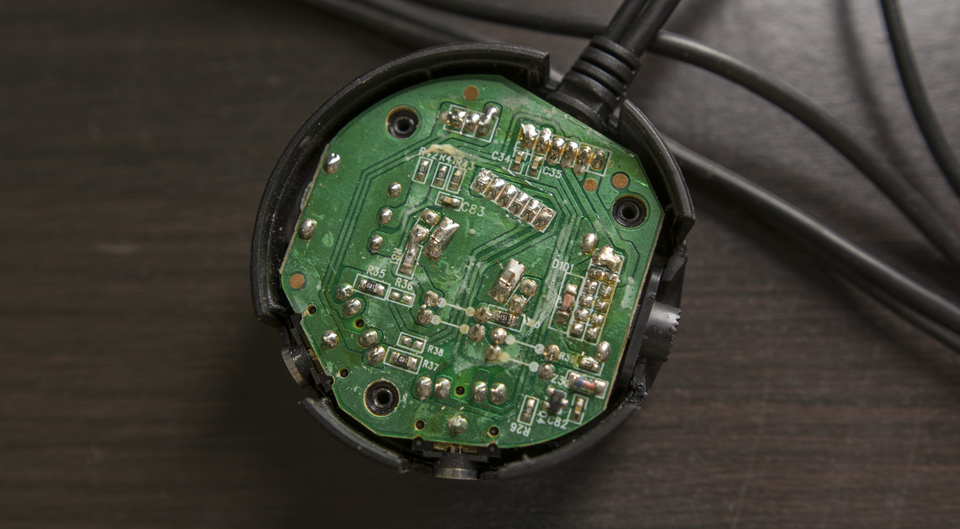
A look inside the mind of a mad man. I'm no expert at circuit design, but looks like there may be a few bridged pins that should not be bridged.
Desktop Setup:
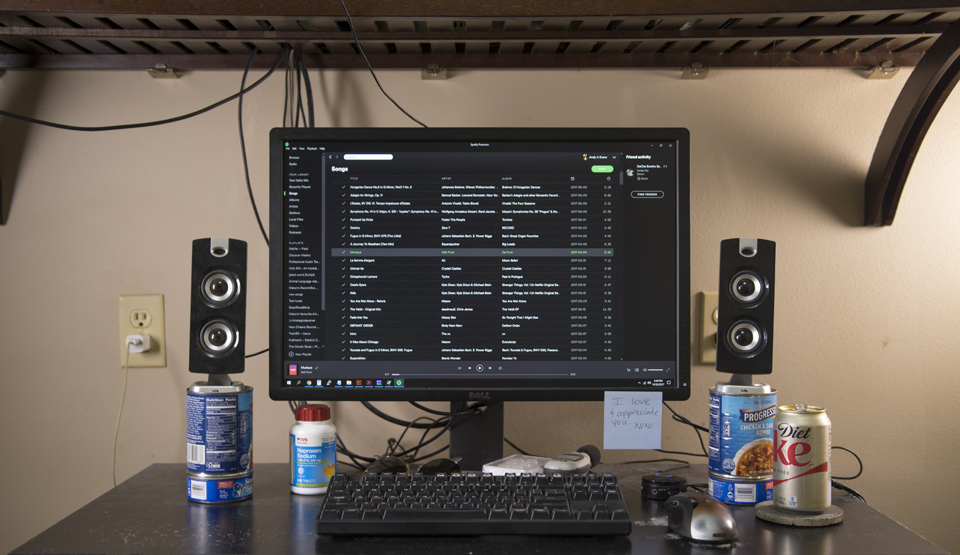
The soup cans are back, but I've got some new lighting in my cave, as well as a love note from my number one fan.
Sounds exits the computer via optical output on the motherboard, and goes to my old Onkyo receiver garage sale pick up, and the CA-3602a's are plugged into the headphone output. I did check to see if there was much of a difference using the computers onboard dac and speaker output. There was a little hiss on it in comparison, but I can't see justifying an outboard dac purchase for $40 worth of speakers. The Onkyo was used mainly to have a nice volume knob.
Putting the speakers up on desktop stands is a requirement of good sound - I'll get into the details of that requirement in the measurement section of the review. Everyone has soup cans, and they work great. Putting some poster tack on the joints will help keep the stands from falling over or rattling.
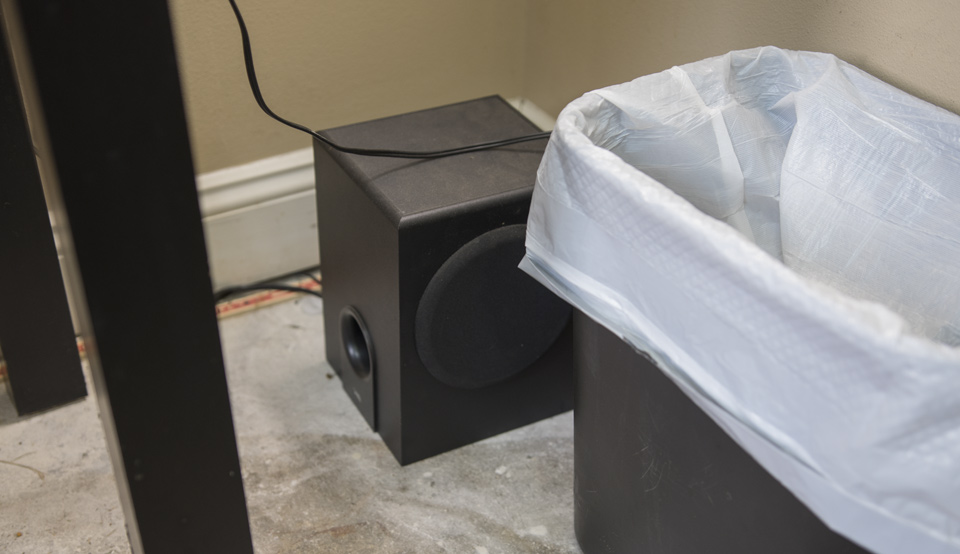
Subwoofer placement is critical considering it's acting as the woofer in the system. The design dictates that it goes to the right side of the desk, otherwise will need to place the sub upside down to keep the sub pointing forward and port firing into the room.
I was lucky to have a corner within reach, but if you do not I recommend placement a few inches away from a wall with the driver pointing the same direction as the satellites. Boundary gain will help with headroom, and having the speaker point the same direction gives you a good shot at avoiding audible phase cancellation in the crossover range(250Hz).
Desktop Listening Impressions:
If you fiddle around with the bass and volume knob for long enough you can get to a place where things sound only mostly horrible.
The volume knob adjusts the treble, and the bass knob adjusts the lower midrange - there is no helping the bass, it's just annoying 110Hz buzzing or nonexistent.
Once adjusted the speakers are "lively" with sharp treble from rising response and cone breakup that is high, but just inside of the hearing range where it is still annoying.
Midrange is muddied by the peaky output of the subwoofer, but turning down the bass knob will just make the midrange disappear.
Tonally it is a strange setup. There are parts missing of the performance, the treble can be distorted to the point of being physically painful. Worst still is the twisting of knobs on the nightmare interface leaves you thinking that you bear some responsibility for the audio performance abomination. Still, I can see why this system is so popular. There is no other way to get this quantity of sound for any less money.
Measurements:
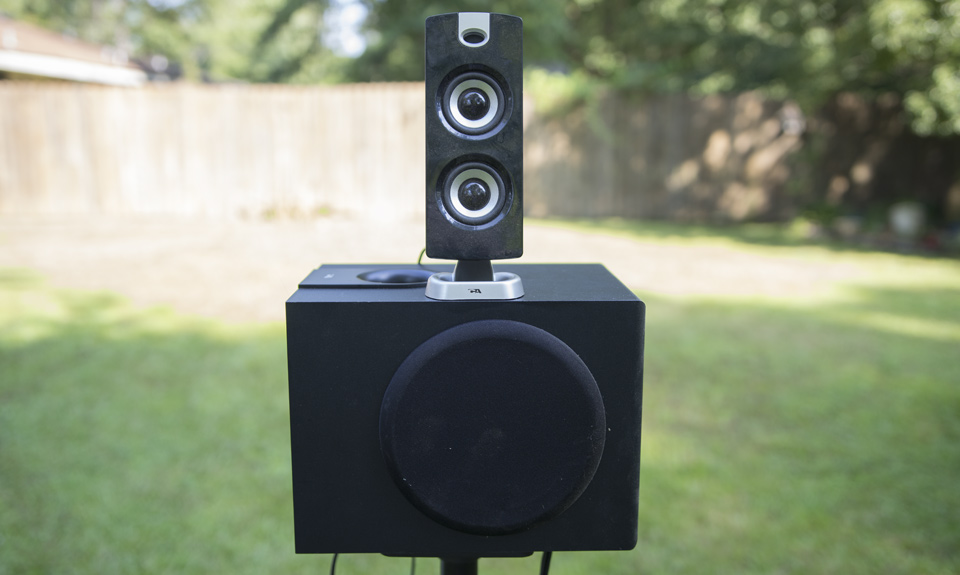
These measurements were part of the summer batch where I spent a weekend baking my audio gear in the sun to get nice reflection free measurements for around 30 pair of speakers. Ended up killing a channel in my Behringer iNuke amp, but it's still got 3 good ones and the data is well worth the effort.
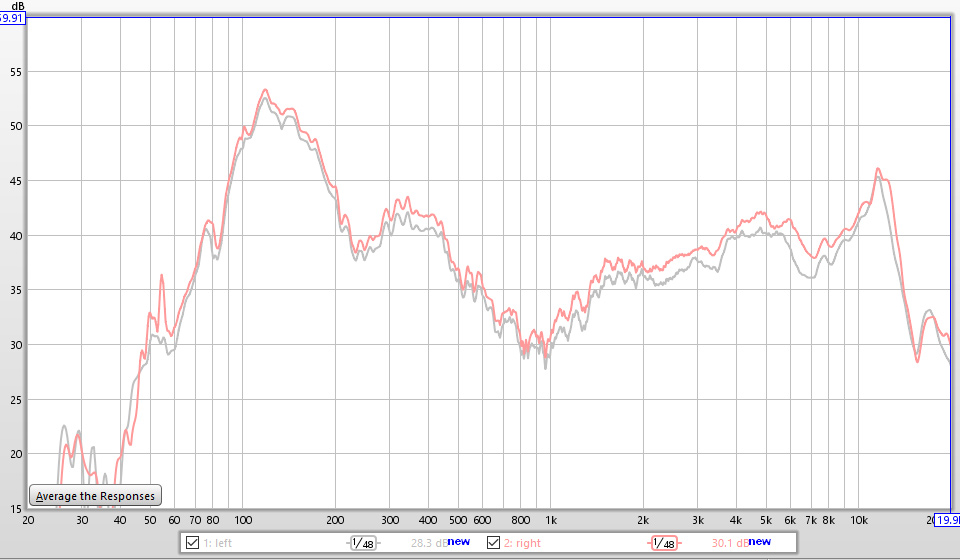
This measurement is taken with the volume knob in the middle position, and the bass turned all the way up. We can see the cone breakup at 11.5kHz, it's so high because of the small size of the drivers. This is almost acceptable, and when EQ is applied to take out the rising response even golden ears would be hard to find the break up distortion by ear.
The "subwoofer" response is just as bad as expected with a 22dB peak at 110Hz. This is exaggerated from the bass knob position, but I wanted this measurement for use in DSP correction.
The right speaker was 2dB louder than the left, so I adjusted that in windows control panel during listening sessions. This kind of anomaly is part of the fun of ruthlessly cheap speakers.
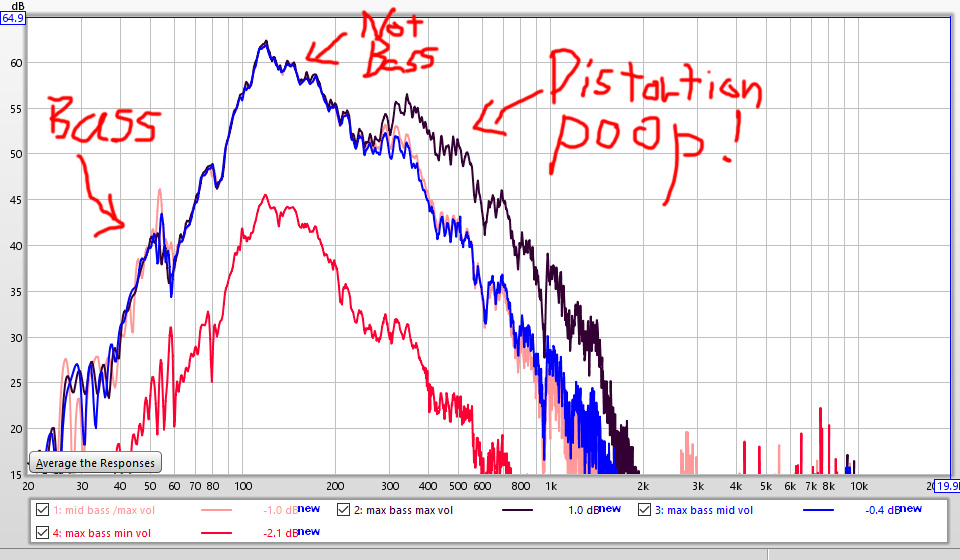
These measurements are with the satellite speakers unplugged and taken while still on the stand - not ground plane, so there is a bit of floor bounce reflection data.
My detailed notes here indicate where da bass, and where not da bass. Also trying to turn up the volume and bass all the way at the same time gives a nasty distortion that is audible even from the subwoofer.
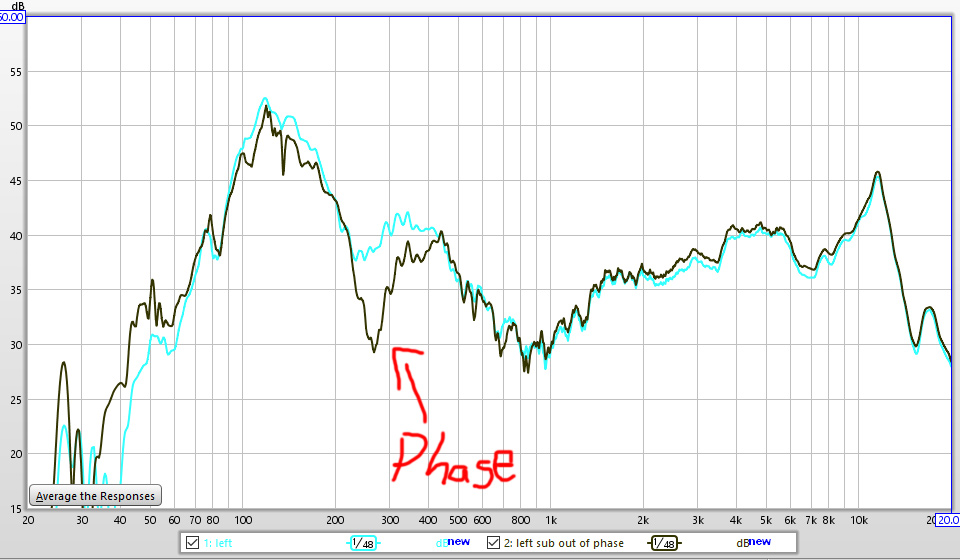
In this measurement I turned the subwoofer around to point in the opposite direction of the satellites. You can see the phase cancellation in the crossover range. This indicates that the crossover happens at 250Hz, and also shows the damage poor placement of the subwoofer can do to the sound.
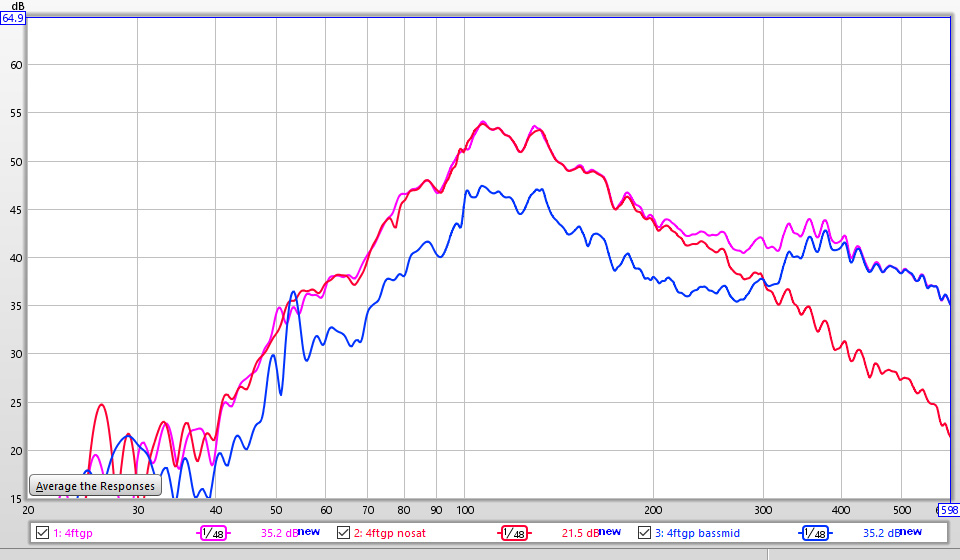
Here are the actual ground plane measurements which will not have any reflection interference. You can see in the blue measurement the bass knob in the mid position and how poorly it integrates with the satellite. Red measurement is without the satellites and max bass, pink is with sats and bass at max.
Listening Window Insanity
Now we get to the fun part, where I learned something cool. I've heard plenty, but never owned an MTM speaker of any quality, and outside of reading D'Appolito's article introducing MTM systems, I had only a cursory idea of what an MTM does when it is properly designed. With MTM speakers the driver spacing of the midranges is supposed to be as tight as possible, and crossover to a single tweeter before they go outside of this golden zone. This means that the two drivers act like one speaker, and create a narrow lobe of flat sound that points straight forward and cancels at 45 degrees vertical off axis. I had no idea what happened when you just ignored the guidelines and ran with no tweeter and seemingly arbitrary space between the mid drivers.
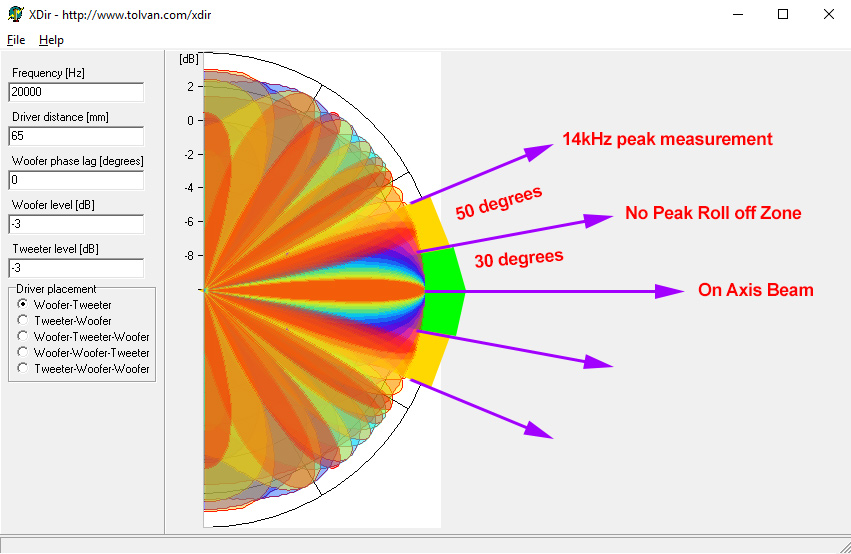
This diagram is the product of what can only be described as an alcohol induced episode of autism.
I started with Tolvan's XDir software, which simulates drivers as a point source on an infinite baffle. The Cyber Acoustics CA-3602a 2 inch drivers are damn near point sources, but the little enclosure is as far as you can get from an infinite baffle. Needless to say without this software I would have never figured any of this out so big thanks to Tolvan.
Using the software and knowing the 65mm driver spacing I was able to simulate the lobing behavior at 1k intervals from 1kHz to 10kHz and 2kHz steps up to 20kHz. I color coded each one of these steps and overlaid them all in translucent layers.
The end result shows a very narrow beam of rainbow awesome where the highs roll off in a very orderly way in the first 15 degrees. Then as you move further off axis you start to see what looks like cone breakup slide it's way from 20Khz down the frequency chart, till it reaches 10kHz and another spike appears at 20Khz and they both slide their way down till the drivers own vertical directivity takes over and reduces the output.
IT looks like a mess, but in reality it's not near as bad as you would imagine. You get a very narrow clean beam that acts like some kind of dirty version of a big ribbon tweeter. After figuring this out I immediately thought of Tekton's Double Impact tweeter array, which is probably using this same effect and has gotten mostly positive press from the mostly positive audio press(I still need to hear them before recommending them).
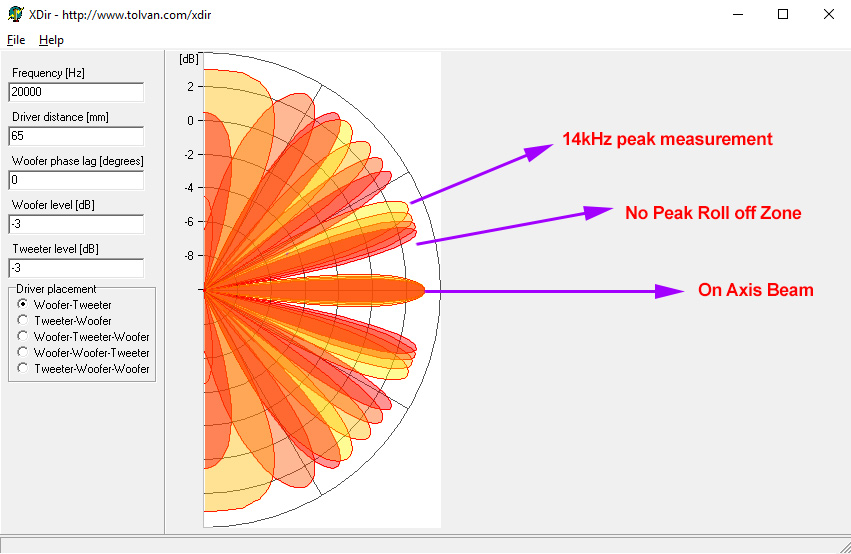
If that other diagram was too much, here is a version showing only the 20kHz, 18kHz, 16kHz and 14kHz lobe positions.
Now, why 14Khz, because that is going to be the upper limit on noticing anything going wrong for most careful listeners.
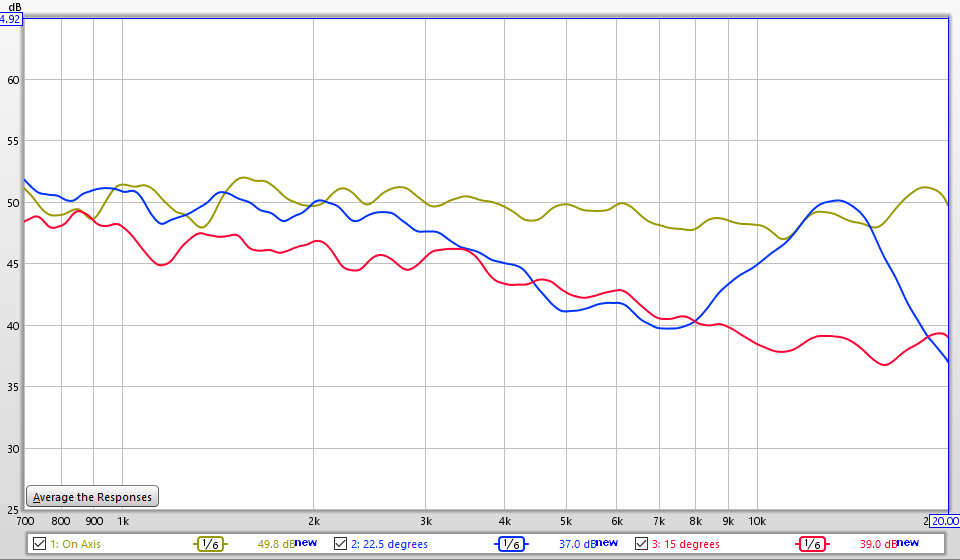
Here are the measurements that started it all. These were taken in room after I finalized the DSP correction, which is why you don't see the speaker's natural nasty peaks. The smooth roll off of highs is better than most 2 way speakers at vertical directivity, even large horn systems with low crossover points. Based on what I see here a system built with high quality drivers and amps using these same ideas has a pretty good shot at not sucking.
DSP Correction:
The DSP correction and careful placement makes the Cyber Acoustics CA-3602a speakers good. The output is limited to 85dB for bass heavy music, due to the increased bass bandwidth. Still, I like the Cyber Acoustic speakers once corrected better than the corrected Logitech z623, and even the Audioengine A2+. The narrow vertical dispertion is really good at minimising desktop reflection, and does a great job with imaging. I even had a buddy come by and give it a listen, and the correction got high marks for bass clarity and neutral tone.
Now for the bad news, do to possible manufacturing discrepancies in cheap products like this I'm not releasing the DSP correction to the public because I'd like to get some feedback from owners of the CA-3602a systems first. If you own this system and would like to beta test this DSP correction send me an email with the date your system was made/when you bought it(there is a sticker on the subwoofer). I'll send you the correction file and instructions on how to install them, but I'm not doing tech support. Once I get enough feedback and know I have something applicable to the systems out there I'll publish the corrections.
Final Thoughts:
The Cyber Acoustic 3602a speakers are garbage, but very interesting garbage that is dirt cheap. I learned a bunch in this review, and am glad I spent so much time working on this review and getting it right. Hopefully the DSP correction works for most CA-3602a systems out there and maybe a few million users can have good sound for almost nothing.
Review Scores:
| Build Quality | |
| Tweeter | - |
| Woofer | 1 |
| Cabinet | 1 |
| Features | 4 |
| Crossover | 0 |
| Amp | 1 |
| Subwoofer | 0 |
| Score | 1.2 |
| Sound Quality | |
| Neutrality | 0 |
| Bass | 0 |
| Extension | 0 |
| Treble | 0 |
| Midrange | 0 |
| Headroom | 4 |
| Dispersion | 7 |
| Detail | 0 |
| Imaging | 4 |
| Score | 1.7 |
| DSP Sound Quality | |
| Neutrality | 5 |
| Bass | 2 |
| Extension | 5 |
| Treble | 1 |
| Midrange | 3 |
| Headroom | 3 |
| Dispersion | 7 |
| Detail | 2 |
| Imaging | 4 |
| Score | 3.7 |
Click here to buy these speakers at Amazon.
Check out the system finder to see stuff I recommend that costs a little more.
Other content you may like:
- Vanatoo Transparent One Review - Software update brings new standard of performance!
- Lone Star Audio Fest 2018 - Staying up late, drinking too much, smoking like chimneys!
- Andrew Jones goes back the be begining, ELAC B5.2 Debut 2.0 Review is up!
- New Scores for all reviewed speakers - Compare and sort for fun!
- Creative Sound Solutions DIY Solution for the high end - CSS Criton 1TD v2 review is up!
- Dayton Makes a Budget Desktop speaker with a crossover - Dayton Audio MK402 review is up!
- Smaller than small, deeper than deep - iLoud Micro Monitor review is up!
- Vanatoo's new speaker, The Transparent Zero review is up!
- SVS Prime Bookshelf Review is now available for your viewing pleasure
- ELAC A-Stock UB5 Listening Impressions are up!
- 30 years in the making, the ancient Bose 901 finally gets measured - The Bose 901 review is up!
- Lock and load, we are hitting the bottom of the barrel with both barrels - The Logitech z313 review is up!
- Bulletproof speakers... No, it's just the B&W 686 S2 Review!
- Declare independence from the British sound! - The KEF Q300 review is up!
- Recommended System Finder - Just in time for the Holidays!
- JBL LSR308 Studio Montor - Super Massive Epic Review!
- Two years after starting this site I finally get around to talking about my stereo.
- Small and cheap speakers transform into retarded and good... Micca COVO-S Review!
- AMT tweeter on a B652? The Dayton B652-AIR is reviewed for great justice!
- JBL LSR305 Studio Monitor Review!
- Zu Essence Review!

